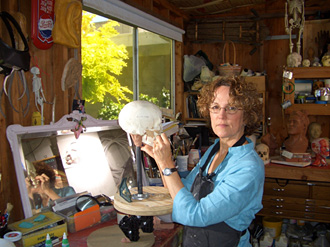A face emerges, a crime is solved
December 14, 2007 -- In 2003 the remains of a young woman were discovered behind a Castro Valley restaurant. After more than three years, the victim's identity had yet to emerge. "It was heart-wrenching," recalls lead detective Sgt. Scott Dudek of the Alameda County Sheriff's Office. With nowhere else to turn, he ordered the body exhumed and called forensic artist Gloria Nusse.
Forensic artist Gloria Nusse places clay on a mold of a murder victim's skull inside her Clay and Bones studio. Photo: David Dellaria
The SF State anthropology graduate student and anatomy instructor made a mold of the young woman's skull at her Clay and Bones studio in Mill Valley. What followed was detailed on "The Girl Next Door," a recent 48 Hours Mystery episode.
"The work I do is a last-ditch effort," says Nusse, whose portfolio spans museum reconstructions of Miwok Indians to those of suicide and murder victims for law enforcement. "I get called in when a case is completely cold. My sculpture can be used as a tool to generate new leads."
Nusse's intricate process starts with identifying the proper tissue depth at a number of landmarks across the facial area of the skull. Various measurements are made to determine such factors as nose thickness and length and eye placement. "It's based on anatomical studies that go back to the 1800s," Nusse says, explaining that race, gender and age determine tissue depth.
Morgue photos can offer clues. In this case, because cartilage had yet to decompose, Nusse learned about the shape of the victim's ears and nose. "A lot of times you can see the hair color, clothing, jewelry. It's like puzzle pieces. And the skull to me is another puzzle. The information is all there."
Her earliest lessons in facial reconstruction came from SF State Professor Emeritus Roger Heglar. "He was my first teacher of this technique," says Nusse, who visited Heglar's lab in the late 1980s when she was working as a scientific artist and sculptor at the California Academy of Sciences. She later took a physical anthropology course from Heglar, and after starting a family, returned to pursue her master's degree.
The challenge with forensics art is to stay within the confines of your subject, Nusse says. "A lot is involved in identification beyond making the person look like a person -- it has to look like the right person. If an eye is asymmetrical, you make it asymmetrical. You don't take off and start creating."
"Finishing is the most satisfying part," she says. "The technique does work."
Last year Sgt. Dudek took Nusse's sculpture to Yahualica, Mexico, the hometown of a person of interest last seen with the victim. The sculpture was placed prominently in the town's square. Flyers with photos of the sculpture were also handed out. Jane Doe was soon identified as Yesenia Nungaray.
The 16-year old had sought out a new life in the U.S. but was killed just three weeks after her arrival. Dudek says, "There's no way people would have made the connection without Gloria. This case wouldn't have come to a conclusion without her -- she's right up there with the best of the best."
To watch the program featuring Nusse's forensic artistry, visit the 48 Hours Web site.
-- -- Adrianne Bee
Share this story:

